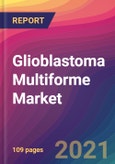This report on global glioblastoma multiforme market studies various drugs used for treatment of glioblastoma along with pipeline analysis of upcoming potential drugs. Glioblastoma multiforme is the most common and most aggressive cancer that begins within the brain. According to Brain Tumour Foundation of Canada, The incidence of glioblastoma multiforme (GBM) is 2 to 3 per 100,000 people in the United States and Europe. GBM accounts for 12 to 15% of all intracranial tumours and 50 to 60 per cent of astrocytic tumours.
For the purpose of this study, the various drugs studied include bevacizumab, temozolomide, and carmustine. Market size estimates and forecast for these segments for the period 2013 to 2029 are provided in terms of USD Mn along with the respective CAGRs for the period 2021 to 2029, considering 2020 as the base year.
The pipeline analysis for glioblastoma multiforme market comprises projected market sales of Phase III drugs estimated till 2029. The phase III drugs included in the pipeline analysis are TRC-105, VB-111, TOCA 511, DCVax-Brain, Rindopepimut (CDX-110), and others. The report also covers qualitative information associated with the drugs under phase II and I of the clinical trials.
The geographic segmentation of the global glioblastoma multiforme market is performed for the regions North America, Europe, Asia Pacific and Rest of the World markets. The regions are also further sub-segmented on the basis of major countries. Market size estimates and forecast for these segments for the period 2013 to 2029 are provided in terms of USD Mn along with the respective CAGRs for the period 2021 to 2029, considering 2020 as the base year.
According to American Association of Neurological Surgeons (AANS), The National Cancer Institute estimates that 22,850 adults (12,630 men and 10,280 women) were diagnosed with brain and other nervous system cancer in 2020. It also estimates that in 2020, 15,320 of these diagnoses resulted in death. Glioblastoma multiforme (GBM) has an incidence of two to three per 100,000 adults per year, and accounts for 52% of all primary brain tumors. Overall, GBM accounts for about 17% of all tumors of the brain (primary and metastatic). It is categorized as one of the orphan diseases with high mortality rate.
This product will be delivered within 2 business days.
For the purpose of this study, the various drugs studied include bevacizumab, temozolomide, and carmustine. Market size estimates and forecast for these segments for the period 2013 to 2029 are provided in terms of USD Mn along with the respective CAGRs for the period 2021 to 2029, considering 2020 as the base year.
The pipeline analysis for glioblastoma multiforme market comprises projected market sales of Phase III drugs estimated till 2029. The phase III drugs included in the pipeline analysis are TRC-105, VB-111, TOCA 511, DCVax-Brain, Rindopepimut (CDX-110), and others. The report also covers qualitative information associated with the drugs under phase II and I of the clinical trials.
The geographic segmentation of the global glioblastoma multiforme market is performed for the regions North America, Europe, Asia Pacific and Rest of the World markets. The regions are also further sub-segmented on the basis of major countries. Market size estimates and forecast for these segments for the period 2013 to 2029 are provided in terms of USD Mn along with the respective CAGRs for the period 2021 to 2029, considering 2020 as the base year.
According to American Association of Neurological Surgeons (AANS), The National Cancer Institute estimates that 22,850 adults (12,630 men and 10,280 women) were diagnosed with brain and other nervous system cancer in 2020. It also estimates that in 2020, 15,320 of these diagnoses resulted in death. Glioblastoma multiforme (GBM) has an incidence of two to three per 100,000 adults per year, and accounts for 52% of all primary brain tumors. Overall, GBM accounts for about 17% of all tumors of the brain (primary and metastatic). It is categorized as one of the orphan diseases with high mortality rate.
Based on the type of drugs, the glioblastoma multiforme market is segmented into:
- Temozolomide
- Bevacizumab
- Carmustine
For the purpose of this study, the global glioblastoma multiforme market is categorized into:
- North America
- Europe
- Asia Pacific
- Latin America
- Middle East Africa
This product will be delivered within 2 business days.
Table of Contents
Chapter 1 Preface
Chapter 2 Executive Summary
Chapter 3 Glioblastoma Multiforme Market: Market Dynamics and Outlook
Chapter 4 GlobalGlioblastoma Multiforme Market, By Type of Drug
Chapter 5 Global Glioblastoma Multiforme Market, By Geography
Chapter 6 Company Profiles
Companies Mentioned
- AbbVie Inc.
- Activartis GmbH
- Agenus Inc.
- Arog Pharmaceuticals Inc.
- Bristol-Myers Squibb Company
- Cavion LLC
- Celldex Therapeutics Inc.
- CTI BioPharma Corporation (Formerly Cell Therapeutics Inc.)
- Cortice Biosciences Inc.
- Eisai Co. Ltd.
- F. Hoffmann-La Roche Ltd.
- Exelixis Inc.
- Peregrine Pharmaceuticals Inc.








